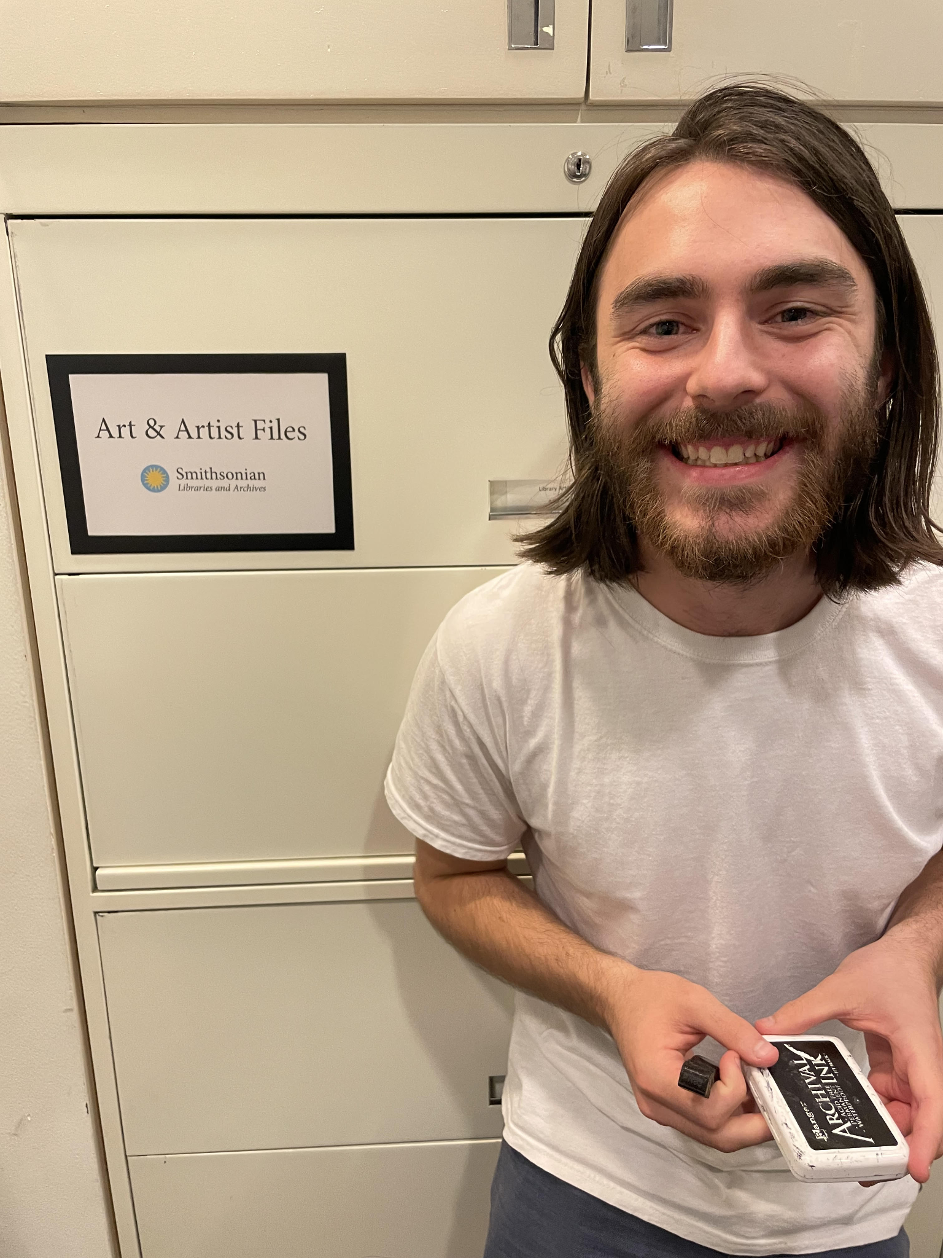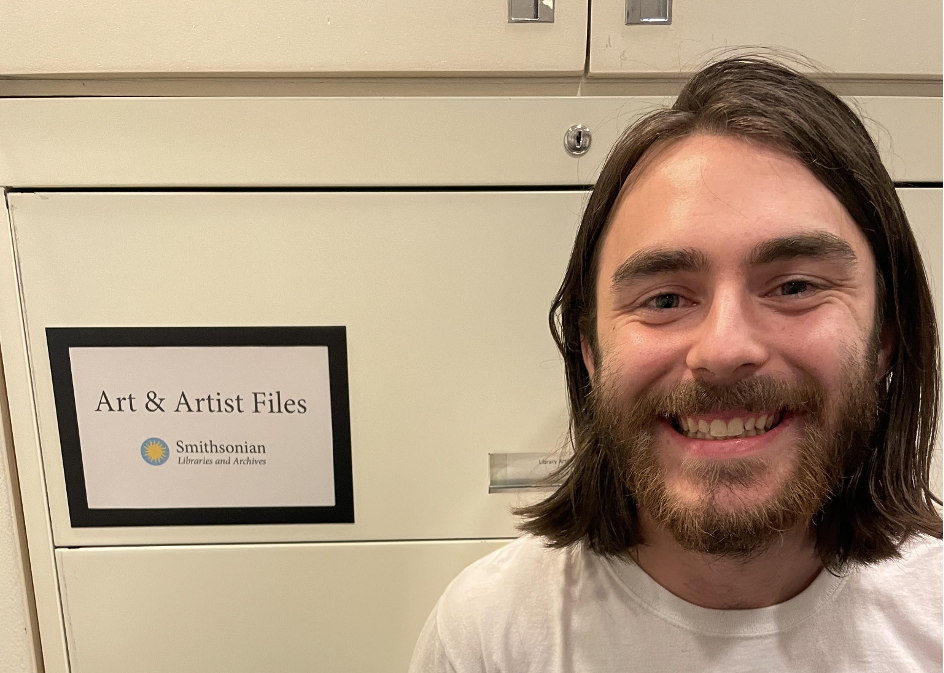My name’s Dawson, and over the summer I worked as an intern at the Hirshhorn Museum and Sculpture Garden Library in DC. I’m currently an Art History and Visual Culture student at Bard College. I applied to the internship last spring with only a little archival experience under my belt, and no idea of how I would live in DC if I even got the position. It was a total leap of faith, and I’m still a little surprised I landed on two feet. In the cover letter, I expressed my belief that “[w]orking with the library’s art and artist files is an opportunity for me to engage directly with the histories of modern American art, and the role of the nation’s emblematic contemporary museum in showing and shaping said histories.” At the time, I had no idea if that would really hold weight or not, but it ended up being more true than I could have expected.
Here was what the job was like, day-to-day, in short. The Hirshhorn has, since its inception, collected various ephemera connected to artists whose work the Hirshhorn was interested in obtaining or ultimately did obtain in its collection. Some of the ephemera even dates to before the museum, when Joseph Hirshhorn had the collection and not yet the institution to hold it. All this ephemera is now stored in the library’s vertical files, one file for each artist. Ephemera is media that is not intended to be preserved long-term – in our collection there are postcards from various artists’ exhibitions, newspaper clippings of reviews, interviews, and obituaries, artists’ resumes and bibliographies, press releases, and lots and lots of advertisements for exhibitions. I would date all of these pieces of ephemera, stamp them with a small “HMSG” insignia, and then sort them chronologically. A lot of these glossy advertisements and obscure clippings aren’t really the kind of media that most libraries preserve, yet they do reflect important auxiliary and parallel histories to more straightforward sources– offering a history of art advertisement, histories of galleries and institutions, and how artists and their art are depicted and remembered on the most immediate levels.

This was my job description on paper, but because of some experience at school working with metadata I took the opportunity to spend a lot of time updating the online entries in the Smithsonian’s Art and Artist’s Files database and on Wikidata (if you’re curious, you can find me on there with the username PalmyranRealness) to better digitally represent the Artist Files’ contents and publicize the material available at the Hirshhorn Museum and Sculpture Garden Library for researchers. I feel strongly that most research in the present day is done online and in order for physical archives to remain used and helpful, there’s a definite need for them to have a digital presence. I updated birth and death dates, created files, clarified exactly which person each file represented (using a unique identification number called a VIAF), all kinds of minutia that make online research easier. In short, my time was spent half and half clarifying both the physical and digital presences of the Hirshhorn Library. So what, after two months, were the takeaways of a beginner’s first foray into library work?
The first takeaway was a practical change in perspective– I hadn’t ever conceptualized the absolute sprawl of artists there are in the world. The Hirshhorn Library really only catalogues information related to artists whose works are in the museum’s collection, and even with that constraint, there are still thousands of artists. In my two months there, working at a pretty consistent pace, I made it through two filing cabinet drawers. Llyn Foulkes to Julio Gonzalez– about a single letter of ground covered, all in all. My title of “A to Z Artist Files Intern” was definitely ambitious in hindsight. There were some well known names whose folders would take me the entire day to sort through– Helen Frankenthaler, Lucian Freud, Alberto Giacometti– and there were countless folders of unsung artists, which took me closer to fifteen minutes to work through. I would spend a long time falling into research rabbit holes, whether it be resolving conflicting birth dates or differentiating between several artists with the same name. (Sidebar– there were three John Ford painters I had to pick apart, and my Google search was severely complicated by the famous Western director. Total mess.) In my personal for-fun research at home, I would normally pick one or two artists, or a circle of artists, and read about them in-depth. But in working for a library, my scope of awareness by necessity widened to whole spheres of art which had never before caught my attention.
For example, I worked on our online entry for Ruth Cyril. I approached this artist as a name on a page and came away with an intimation of more than I can really grasp. I was trying to add birth and death years to the artist’s life, and in the process got lost in the murkiness of her name change and unsung biography. I caught just a glimpse of a wider world of the printmaking renaissance of Atelier 17 and the countless students at said school who went on to have long and varied careers. And then, just like that, I moved on to another name with its own situated culture and story. The world of art, really just the world, is full to the brim of unexamined artwork and unexamined lives and pure detail, pure intricacy. It’s a little overwhelming and humbling to come to a closer awareness of this fact we kind of accept at face level without necessarily having to deal with it. Even a small, neatly limited section of history is unthinkably large when approached with an eye for detail and its smallest, ephemeral pieces.
The second and bigger takeaway is that there is something oddly powerful to the whole process which is difficult for me to voice. I felt like a custodian to artists alive and dead. The word custodian has a janitorial connotation, and that was certainly part of the job. There was a lot of small manual labor that I refined each day to a personal art: rubber stamping, neat pencil handwriting, a tidy spreadsheet. But I felt too, that working on these countless artists in little ways was a small form of invocation, plucking a string somewhere in the vast interconnected web of history that is tying me to art history. Adding someone’s name to a database, their date of birth and death to Wikidata, was like a little resurrection. The organizational microadjustments I did in swaths were part of the culturally vital process of keeping an archive alive. That sounds overly cliche, but I really mean alive, in the sense that being a custodian to this archive made it visible, responsive to change, and part of a living community. It acted on me, and I it, and all that felt indescribably valuable and somehow essential to an historic process. I felt linked to the Hirshhorn’s librarians before me that I knew now by name, to curators and collectors, sculptors and painters, exhibitions long gone, artwork still here, somewhere. Linked, too, to the peers around me, the workers and researchers operating in this huge Smithsonian historical web that’s so large it’s a wonder to me it floats. But through this internship, polishing the organizational structures of all this ephemera, I got a sense of an undercurrent. Something pesky to describe that binds together impossibly wide times and spaces. I think libraries and museums are where you can come closest in contact to that undercurrent. If you’re tempted by this blog post at all, try and dip your toe in, and see if you don’t end up caught in the undertow like me.
Thanks for having me Hirshhorn and the whole Smithsonian Libraries and Archives system, especially to my supervisor Jacqueline Protka who made me feel truly welcome. If you’re curious about the Hirshhorn Sculpture Garden Library, it’s open to the public by appointment and full of untapped knowledge.


Be First to Comment